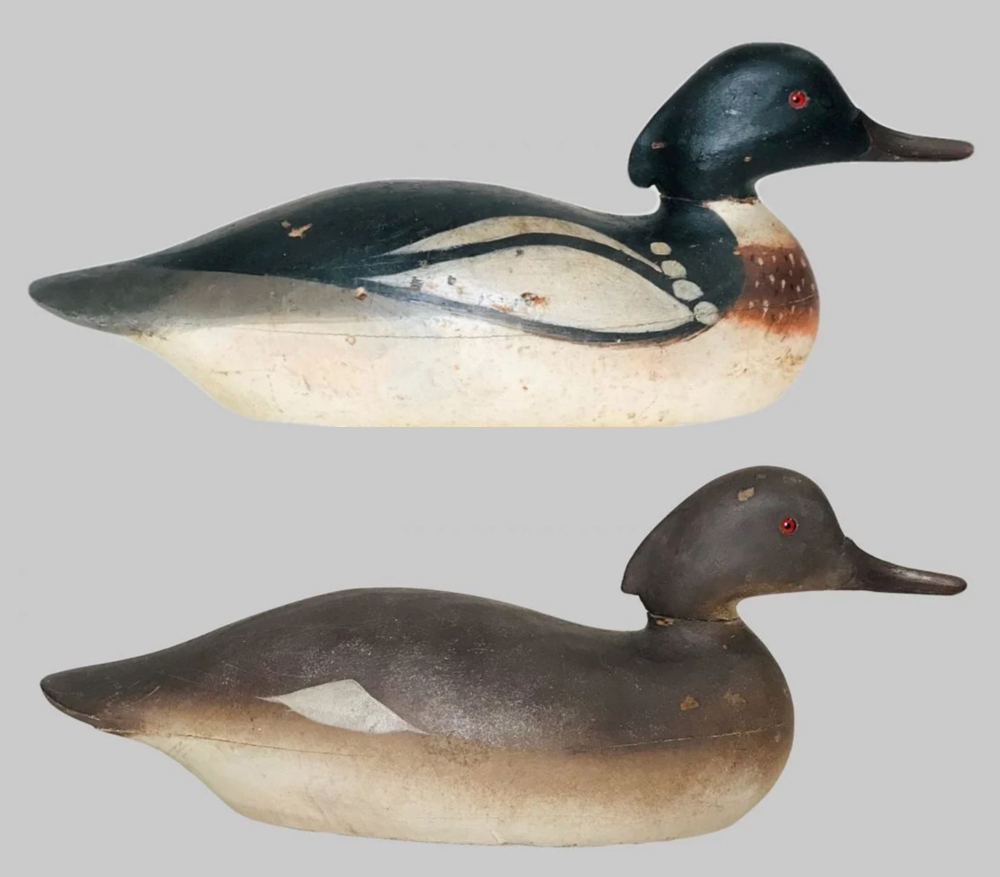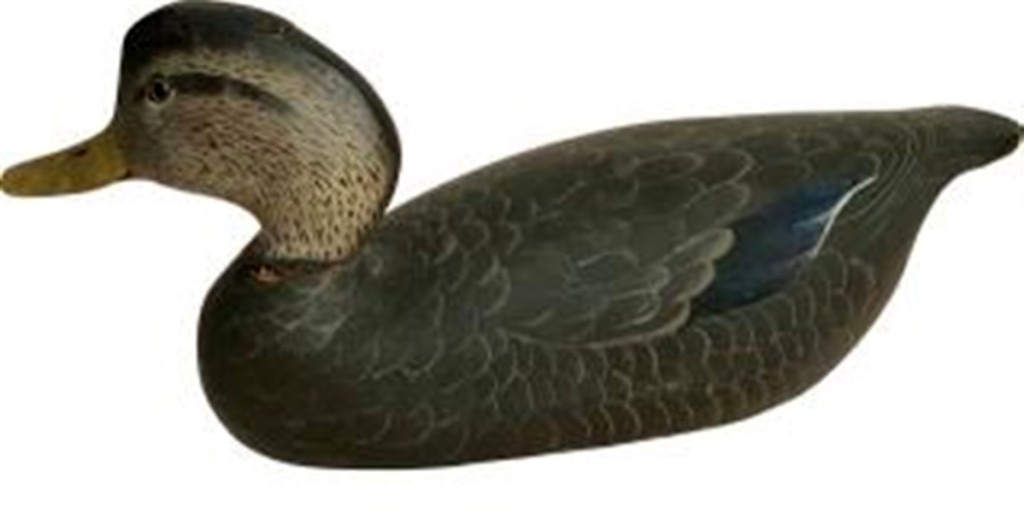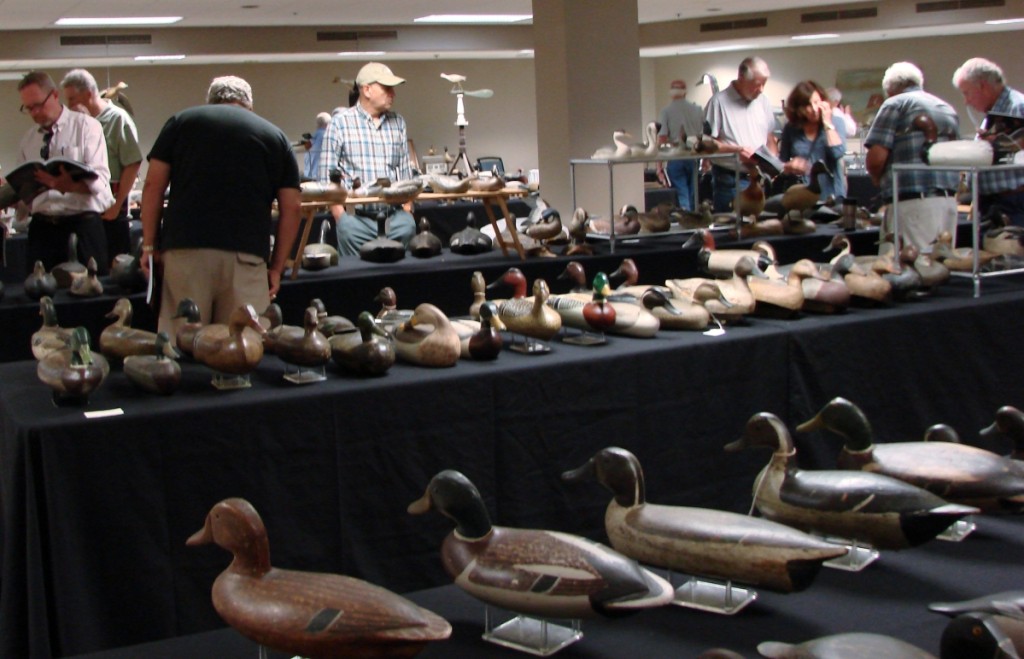
Bringing the highest price of the sale, finishing at $48,000, was a pair of Mason premier-grade, rig-mate red breasted mergansers, circa 1900-1910.
Review and Onsite Photos by Rick Russack, Additional Photos Courtesy Decoys Unlimited
PLYMOUTH, MASS. – On July 26, Ted and Judy Harmon, Decoys Unlimited, conducted their annual decoy sale with 438 lots, including decoys from several parts of the United States, miniatures, decorative carvings and sporting art. The Harmons have been conducting decoy auctions for more than 30 years and have achieved some record prices over that time. This year’s sale included one-of-a-kind carvings by Elmer Crowell, rarities by the Ward Brothers, Harry Shourds, Joe Lincoln, the Mason factory and more.
The Harmons have always liked Crowell carvings – his home and museum are near their home – and this sale included more than 80 of his birds. Ted Harmon has also been the president of the A.E. Crowell American Decoy Foundation. The sale grossed more than $600,000.
Ted Harmon’s approach to collecting reflects the “old time” view that a collectible decoy need not be absolutely mint. “I would say something about condition and rarity. Low prices generally reflect condition. We had birds that were not in pristine condition. I sold them anyway because I believe they have a place in collections where the collector simply loves the form and accepts the fact that these are working birds and it’s okay if they bring less. They don’t care about the ‘minty’ thing. It’s okay that they aren’t mint because if mint they’d bring ten to 100 times the amount in today’s world.”
Topping the sale, finishing at $48,000, was a pair of Mason premier-grade rig-mate red breasted mergansers, circa 1900-10. Harmon’s catalog entry was detailed: “In 100 percent all-original paint, in excellent condition with minimal wear. Only known pair of this exceedingly rare species from what we have been told. Strong, bold paint on both with thick swirls. Please note that there are still small patches of the original aged newspaper used in shipping stuck on the surface indicating the pair saw minimal usage. The drake has been baptized by a few lead shot, and the hen may have been hit by a pellet or two. The hen had a bill break that was glued back offline by the owners that inherited them. When I first saw the pair, the bill was intact. The talented restorer, Russ Allan, was able to loosen the glue and clean the break and re-glue it exactly back together as it should be. It looks great. He did not touch up any part of the bill or bird.”
A Mason Canada goose of the same grade with a repaired neck reached $2,280. The sale also included about 20 other Mason factory birds. A challenge-grade brant earned $1,320 and a standard-grade blue-winged teal drake sold for $540. According to a circa 1905 price list published on Russ Goldberger’s website, premier-grade decoys sold for $12 per dozen and challenge-grade decoys were priced at $8 per dozen. Standard-grade birds were less. Goldberger’s website – www.rjgantiques.com – includes information on identifying the different grades and talks about Mason’s production. He has also written, along with Alan Haid, the definitive book on Mason decoys, now in its third edition. It is generally accepted that more people collect Mason decoys than those made by anyone else, with the works of Elmer Crowell coming in second.

This black duck hen was made by the Ward Brothers to the order of Dr Davenport West. The brothers, of Crisfield, Md., were among the few carvers to differentiate black duck drakes from hens by using different colors for the bills of each. This hen brought $15,000.
Of particular rarity and generating strong prices was a group of life-size songbirds carved by Elmer Crowell to the special order of Dr Davenport West in 1925, with additional examples from the collection of Joel Ellis, author of Birds in Wood and Paint. West’s order to Crowell listed the species he wanted and said, “My Dear Mr Crowell, will you please proceed with making the following birds, life size. There will probably be additions to this list, but I’m sending you this list now so there will be no further delay.” That initial order, for 15 birds, cost $100. Over the next few years, and into the Depression, West ordered birds at higher prices, which tends to indicate that Crowell’s business was not substantially affected by the Depression. Harmon’s catalog included several photos of each bird.
Several of the birds offered from the Davenport collection are the only known examples, and the provenance is clear: from Crowell to Davenport, to his grandson, to this auction. Bringing the highest price of the group was a life-size screech owl, which finished at $20,400. This species is one of the rarest Crowell produced. A life-size rose-breasted grosbeak, the only one known, was the first of the group to be sold and it brought $7,800, while a life-size kingfisher with a fish in its beak went for $9,600 and a life-size blue jay realized $7,800. Demonstrating how business was conducted in those days, another group of 11 miniatures came from the collection of Horace Bearse, who traded his plumbing work with Crowell for the birds. Several of these went to one bidder. A miniature crook-necked Canada goose realized $4,320, an avocet brought $3,840 and a miniature dowitcher earned $3,480.
Harmon, it’s fair to say, has seen a lot of decoys carved by Crowell. When he says “without question, the finest miniature carving we have seen” by Crowell, one has to take note. That’s the way he referred to a miniature “hanging” Canada goose with outstretched wings folding around the body, with detailed carving on the tail, head and bill. It would seem that bidders agreed with Harmon, as the miniature sold for $19,200.
The sale included more than two dozen decoys made by Joe Lincoln of Accord, Mass. A self-bailing scooter, canvas over frame, earned $330, and a circa 1901 merganser drake went for $1,920. An oversized black duck, circa 1920, was the most popular with bidders, finishing at $2,520. Five shore birds by Lincoln each brought more than $1,000.
Exceptional Ward Brothers decoys were included in this sale, most notably a black duck hen and its rig mate, a black duck drake. The hen sold for $14,400 and the drake for $10,000. Both were made especially for Colonel Albanus Phillips for use by members of the Bishops Head Club in 1921. The colonel was a successful businessman, serious about hunting. He owned several square miles of Chesapeake Bay waterfront and was said to have hosted both Presidents Roosevelt, Walter P. Chrysler, Admiral Byrd and other wealthy sportsmen. The colonel asked the Ward Brothers to make a special rig of goose and duck decoys for his hunting club, which had previously used live decoys. The decoys in this rig had details not found on other Ward Brothers birds. Additional Ward Brothers decoys in the sale included a bluebill hen, which brought $3,600.
Numerous other decoys in the sale included a canvasback drake by James Holly, which earned $9,600, and a mallard hen by Charles Walker that sold for $8,880. A bluebill hen by Rowley Horner, West Creek, N.J., reached $8,100. In keeping with Harmon’s willingness to offer decoys with minor condition issues, many decoys in this sale could have been bought for less than $500. A goldeneye drake by Marty Collins earned $120. A red-breasted merganser drake by James H. Whitney, Falmouth Foreside, Maine, went for $150 and a miniature flying Canada goose by Russ Burr sold for $300.
Ted Harmon has been collecting decoys since the age of 15 when he recovered some from a bottle dump. He used them for hunting. He conducted his first decoy auction in 1986. A few days after the sale, Harmon talked about his trio of “Dust Jacket Plovers” that had sold the day before for $1,114,000. “I was shocked that they brought that price,” he said. “I had hoped that the three would stay together, but one buyer bought two of them, and I think he was the underbidder on the third. I know the guy well. I’ll be hunting with him later this year. I knew the guy had a lot of confidence in Steve [O’Brien] and would listen to his advice.”
Harmon was asked how it feels to wake up one morning with a million dollars more than he had the day before. “Though I miss the birds, it’s ‘comforting’ to have that money in reserve. Decoys have been a very good investment for me over the long term. I had a good eye for decoys and that really helped.” He also stated that he is looking into the possibility of future sales being conducted in Portsmouth, N.H., in conjunction with the other decoy sales, and commented, “No sales tax there, saves the customers some money.”
Prices given include the buyer’s premium as stated by the auction house. For more information, www.decoysunlimitedinc.net or 508-362-2766.



























